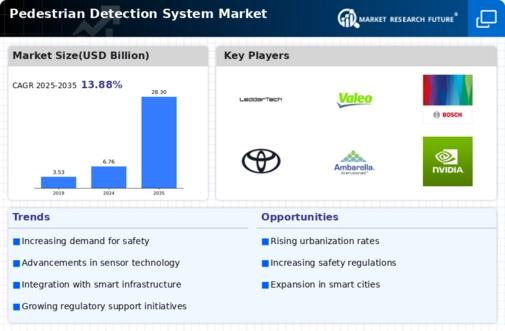Increasing Road Safety Concerns
The rising awareness regarding road safety is a pivotal driver for the Pedestrian Detection System Market. As urbanization accelerates, pedestrian accidents have become a pressing issue, prompting governments and organizations to seek innovative solutions. The implementation of pedestrian detection systems is seen as a proactive measure to enhance safety. According to recent statistics, pedestrian fatalities have surged, leading to a heightened demand for advanced safety technologies. This trend indicates that stakeholders are increasingly investing in systems that can effectively reduce accidents and protect vulnerable road users. Consequently, the Pedestrian Detection System Market is likely to experience substantial growth as municipalities and automotive manufacturers prioritize safety features in their vehicles and infrastructure.
Government Regulations and Standards
Government regulations and standards play a crucial role in shaping the Pedestrian Detection System Market. Many countries are implementing stringent safety regulations that mandate the inclusion of advanced driver assistance systems (ADAS) in vehicles. These regulations are designed to reduce pedestrian injuries and fatalities, thereby driving the adoption of pedestrian detection technologies. For instance, certain regions have set specific deadlines for compliance, which has led to increased investments from automotive manufacturers in developing and integrating these systems. As regulatory frameworks evolve, the Pedestrian Detection System Market is likely to witness accelerated growth, as compliance becomes a necessity for market players.
Rising Adoption of Autonomous Vehicles
The growing trend towards autonomous vehicles is a significant driver for the Pedestrian Detection System Market. As manufacturers develop self-driving technologies, the need for advanced pedestrian detection systems becomes paramount to ensure safety. Autonomous vehicles rely heavily on accurate detection and classification of pedestrians to navigate urban environments effectively. Market projections indicate that the autonomous vehicle segment will expand rapidly, leading to increased demand for sophisticated detection systems. This trend suggests that the Pedestrian Detection System Market will benefit from the convergence of autonomous technology and pedestrian safety, creating new opportunities for innovation and growth.
Integration with Smart City Initiatives
The integration of pedestrian detection systems with smart city initiatives is emerging as a vital driver for the Pedestrian Detection System Market. As cities evolve into smart environments, the need for interconnected systems that enhance urban mobility and safety becomes increasingly apparent. Pedestrian detection systems can be integrated with traffic management systems, providing real-time data that improves traffic flow and reduces accidents. This synergy not only enhances pedestrian safety but also contributes to the overall efficiency of urban transportation networks. As cities invest in smart technologies, the Pedestrian Detection System Market is likely to see substantial growth, driven by the demand for innovative solutions that address urban challenges.
Technological Innovations in Sensor Systems
Technological advancements in sensor systems are significantly influencing the Pedestrian Detection System Market. The integration of sophisticated sensors, such as LiDAR, radar, and cameras, has enhanced the accuracy and reliability of pedestrian detection systems. These innovations allow for real-time data processing and improved object recognition capabilities, which are crucial for preventing accidents. Market data suggests that the demand for high-performance sensors is expected to grow, driven by the automotive sector's need for enhanced safety features. As manufacturers continue to innovate and refine their technologies, the Pedestrian Detection System Market is poised for expansion, with new products entering the market that offer superior performance and functionality.

















Leave a Comment